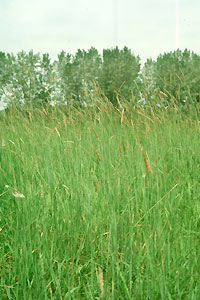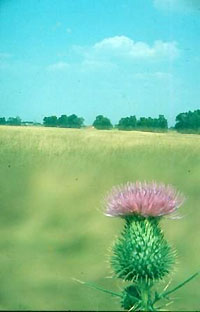 | ||||
| About the Tisza-LIFE programme | ||||
| Relation with partners | ||||
| Model-sites | ||||
| Clay-pits | ||||
| Tóalja | ||||
| Tiszajenő | ||||
| Tiszakürt | ||||
| Kőtelek | ||||
| Habitats | ||||
| Implementation | ||||
| Outreach Activities | ||||
| Results | ||||
| Viktória Siposs, Tisza Programme Officer |
The Nagy-rét ("Big Meadow") is a 200-hectare grassland near Tiszajenő. The Kőrös-ér [a small stream], arriving from the direction of the town of Nagykőrös, makes a sharp turn at the north-west edge of the meadow, goes around the Vár-domb ("Castle Mound") and cuts itself deeply into the ground before entering the Tisza. In the mid-20th century, its course was abbreviated by digging a canal that enters the Tisza on the other side of the Vár-domb. The purpose of this cut-off must have been to accelerate the drainage of unwanted water. There is a strip of hybrid poplar plantation between the meadow and the Tisza. Across much of the area, the elevation difference is no greater than 20 to 40 cm, but it is enough for the wet grassland to develop a mosaic-like vegetation pattern. As lower lying areas dry out they become dominated by hydrophilic species. The pattern of vegetation gives a clear indication of the relief. The 3.5-metre-high Vár-domb clearly emerges from the otherwise flat terrain. It would seem from records that the area has for quite some time been used as pastures. The most important task today is the maintenance of the diverse community of semi-natural grasslands. Regular grazing leads to the dominance of plants which are resistant to browsing and trampling, and which often tend to be of high conservation value. The poor hydrological status poses another risk for conservation. Although following floods lower-lying areas remain moist for an extended period of time, by summer a significant portion of the area will have dried out. This is also detrimental to the economic productivity of the area, as a good supply of water will allow hay to be harvested up to five times a season. The lack of appropriate management (grazing, hay-making) favours the spontaneous establishment of woody vegetation, including the spread of bastard indigo and other adventive species. Despite this the degradation of the area can still be halted and even reversed. With proper management and an adequate supply of water, it can be turned into an exquisite grassland. One of the goals of rehabilitation is the creation of better hydrological conditions by water retention. This will provide suitable habitat for shorebirds, inlcuding waders. Grazing on the Nagy-rét will be conducted according to a management plan adopted to the spatial and temporal pattern created by the relief and hydrology of the area. Higher-lying, areas will be grazed by grey cattle and mowed. Grazing will create a grassland structure that will in the main benefit bird and insect species that favour short grass or bare soil. Cattle will be allowed to graze lower-lying, wet areas only after the breeding season, as those areas support plant communities which are favoured breeding grounds for the redshank (Tringa totanus), the black-tailed godwit (Limosa limosa) and the corncrake (Crex crex). It is expected that the meadow will provide food and an undisturbed habitat also for egrets and the Black stork. Management will be implemented with the involvement of local farmers. |
||||||||||


